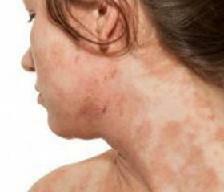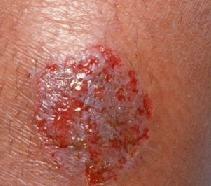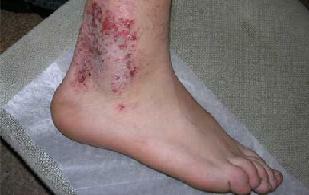 Eczema refers to inflammatory diseases of the skin, which are not transmitted from person to person, being completely non-contagious. As a rule, eczema is presented in a chronic form with temporary exacerbations.
Eczema refers to inflammatory diseases of the skin, which are not transmitted from person to person, being completely non-contagious. As a rule, eczema is presented in a chronic form with temporary exacerbations.
The history of the disease can be hereditary or allergic, it can develop under the influence of exogenous and endogenous factors. Also, the culprits, provoking eczema, include neuroendocrine, immunological and psycho-vegetative disorders.
Microbe eczema, the treatment and symptoms of which we will consider today, most often occurs in humans with weakened immune defense. With a low level of immunity, the body becomes more susceptible to pathogens that enter it.
This is primarily about such common pathogens as staphylococci and streptococci.
Etiology and pathogenesis
Why does microbial eczema arise, and what is it? This disease is classified as a secondary pathology, as it develops against the background of the already existing disease. Depending on the cause of its appearance, eczema is divided into several types:
- Sycosiform- observed in people with inflamed hair follicles. On the skin are formed swollen, inflamed, itchy areas of red color. It is localized in the area of the chin, upper lip, armpit, and genitals.
- Varicose veins- develops on the feet with a neglected case of varicose veins.
- Nummular- has lesions of round shape, with a diameter of 1 to 3 cm, with serous-purulent crusts. Most often manifested in the hands.
- Mitotic- appears when there is a fungal infection on the skin and nails.
- Paratraumatic- develops around a long-standing trauma, especially long-lasting non-healing wounds.
- Eczema nipples- formed in women during breastfeeding, as well as against scabies. Characterized by the appearance of red inflamed spots around the nipple, which strongly wet.
The appearance of eczema may indicate problems with the organs of the gastrointestinal tract, kidneys, malfunctions in the humoral regulation of the body. Also, when the disease is observed disgammaglobulinemia, a decrease in the number of T-lymphocytes, and an increase in the number of B-lymphocytes. These symptoms mean that the true cause of the disease is immune deficiency.
Risk factors
To the risk groupbelong to people:
- being in a state of stress;
- with digestive problems;
- with disabilities of the endocrine system;
- with weak immunity;
- with manifestations of allergic diathesis;
- with allergic diseases;
- with a low level of personal hygiene.
It should be noted that in the pathogenesis and launch of the disease, it is the latter factor that plays a huge role. In most cases, lesions are localized on the legs and hands due to their high sweating and low hygiene in these areas.
Symptoms
 The main symptoms of microbial eczema include inflammatory lesions of the skin, accompanied by a different rash (papules or vesicles), as well as erectile erosion. The process of rash is usually accompanied by severe itching.
The main symptoms of microbial eczema include inflammatory lesions of the skin, accompanied by a different rash (papules or vesicles), as well as erectile erosion. The process of rash is usually accompanied by severe itching.
The foci have large-faceted edges and eventually merge without leaving a healthy skin in the affected area. On the surface of the foci of inflammation of microbial eczema is concentrated a large number of purulent crusts.
Incorrect treatment of microbial eczema or traumatic effects on the lesion can lead to the appearance of secondary allergic rashes. Such rashes differ in polymorphism and can be represented by red-swollen spots, vesicles, pustules and papules.
With the progression of the process, these rashes merge, forming sections of erectile erosion, and spread to previously healthy skin areas. Thus, the microbial eczema is transformed into the true one.
Microbial eczema: photo
How does this ailment in the photo look like, we suggest you read the pictures.

Treatment of microbial eczema
When they discovered microbial eczema, the main task of treatment involves maintaining the body as a whole, because eczema, as a rule, has a chronic nature of the course, so it is very rarely possible to completely get rid of it.
Treatment of microbial eczema on the legs or hands depends on the history of the disease and the results of the studies. It is aimed primarily at treating the underlying pathology and affecting the chronic inflammation focus.
Depending on the cause of the origin of the disease, it is required to treat fungal skin lesions, pyoderma, sycosis or other appropriate pathology. In the case of varicose microbial eczema, treatment includes taking drugs to improve blood circulation.
General recommendations for patientswith microbial eczema include:
- Careful personal hygiene, but exclusion of prolonged contact with water of skin areas with microbial eczema.
- Preventing overheating of the body, as well as traumatizing the affected area.
- Elimination of foci of chronic infection.
- Wearing clothes from natural fabrics.
- The diet is predominantly milk and vegetable with the addition of meat dishes, cereals, fruits, except for citrus fruits. Restriction of reception of a liquid, alcohol, canned and spicy food.
- When varicose form of microbial eczema - wearing dense rubber stockings or bandaging the legs, treatment of varicose veins.
In addition, the treatment includes the use of antiallergic drugs, sedatives, antiseptic and antibacterial agents.
Local Therapy
At home, you can use a local treatment of microbial eczema on the hands or feet, it is as follows:
- Manufactures are made of lead water, as well as 1% resorcinol solution, treatment with Castellani liquid.
- When eczema was triggered by a bacterial pathogen, ointments containing antibiotics are used, for example, Bactroban, dettol.
- If the foci of inflammation have mild staining spots, apply medications with tar content, naphthalene ointment.
- In the case of a fungal pathogen, antifungal ointments are used, for example, Exoderyl, Loceril.
With a more severe form of the disease, it is necessary to use conventional therapy with hydrocortisone ointment and glucocorticosteroid agents that will help you to relieve relapse. In certain cases, these methods of taking these drugs are used constantly with additional supportive vitamin B and C intramuscularly.
After removing the acute phase and stopping the process, it is necessary to apply irradiation on the affected area of the skin with therapeutic ultraviolet. To fix the success of treatment, therapeutic mud is used. It is necessary to protect the skin from the effects of frost, snow, sun, rain, and also cover them with aseptic bandages.

How to choose probiotics for the intestine: a list of drugs.

Effective and inexpensive cough syrups for children and adults.

Modern non-steroidal anti-inflammatory drugs.

Review of tablets from the increased pressure of the new generation.
 Antiviral drugs are inexpensive and effective.
Antiviral drugs are inexpensive and effective.



